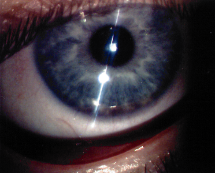
Prescribing soft contact lenses for astigmatism
Soft Toric Contact Lenses
In 1974, the German optometrist Peter Fanti filed a patent application for a soft toric
contact lens; the lens developed by Fanti had a so called “dynamic stabilisation” and was
manufactured by Titmus Eurocon (later CIBA Vision). In 1976, soft toric contact lenses
were approved by the FDA.
Today a multitude of disposable as well as conventional toric soft lenses are available.
As a rule of thumb, when fitting soft contact lenses for astigmatism in the threshold
region of 0.75D, practitioners must estimate the necessity of toric soft CLs via an over
refraction over spherical lenses.
Looking at the EUROMCONTACT data from 2009 (A Comparison of Soft Contact Lenses
and Lens Care Markets in Europe in 2009), conventional soft contact lenses are declining
rapidly in Europe. On the other hand, the parameter availability of soft toric disposable
lenses is limited. For that reason, practitioners have to prescribe and fit custom-made
soft toric contact lenses in cases in which soft disposable lenses are not available or
appropriate.
Stabalization principles
In regard to fitting such lenses, the practitioner
must keep the different stabilization principles in mind:
• Prismatic stabilisation
• Dynamic stabilisation
• Dynamic-prismatic stabilisation
• Truncation (rarely used today)
The fitting principles of soft toric contact lenses are similar to those of soft spherical
lenses, but special attention must be paid to how the lens is stabilized.
In this context, the practitioner must be familiar with the lid anatomy and the corneo-
scleral profile. In addition, the direction and power of the cylindrical error and the lens
thickness profile have a huge influence on lens rotation and movement.
Prismatic stabilisation works best for:
• high or low upper lid position
• low lower lid position
• a strong or weak lid tension
• small contact lens diameters
Dynamic stabilisation works best for:
• normal lid position
• normal lid tension
• higher lens power
• large lens diameters
Furthermore, it is important to know that the stabilisation of a soft toric contact lens is
inappropriate if the lens is fitted too tight.
Most manufacturers of custom-made soft toric contact lenses offer trial lenses for the
determination of lens stability. Other manufacturers produce the first custom-made lens
on the basis of the patient’s anatomical, topographical and refractive data. In such cases,
the determination of the final lens is often easier and less time consuming.
Summary
Thirty-six years after the first soft toric contact lens was patented, a large variety of different
soft toric disposable and custom-made contact lenses are available to correct patients’
astigmatism. In cases in which custom-made soft toric contact lenses are necessary, the
practitioner has to decide which contact lens design and material is adequate. A proper
knowledge about the pros and cons of the different lens designs and materials and their
respective orientation characteristics, in consideration of the anatomy of the anterior eye
segment, the tear quality and quantity and also the type and amount of the refractive error,
is a prerequisite for a successful contact lens treatment
Soft Toric Contact Lenses
In 1974, the German optometrist Peter Fanti filed a patent application for a soft toric
contact lens; the lens developed by Fanti had a so called “dynamic stabilisation” and was
manufactured by Titmus Eurocon (later CIBA Vision). In 1976, soft toric contact lenses
were approved by the FDA.
Today a multitude of disposable as well as conventional toric soft lenses are available.
As a rule of thumb, when fitting soft contact lenses for astigmatism in the threshold
region of 0.75D, practitioners must estimate the necessity of toric soft CLs via an over
refraction over spherical lenses.
Looking at the EUROMCONTACT data from 2009 (A Comparison of Soft Contact Lenses
and Lens Care Markets in Europe in 2009), conventional soft contact lenses are declining
rapidly in Europe. On the other hand, the parameter availability of soft toric disposable
lenses is limited. For that reason, practitioners have to prescribe and fit custom-made
soft toric contact lenses in cases in which soft disposable lenses are not available or
appropriate.
Stabalization principles
In regard to fitting such lenses, the practitioner
must keep the different stabilization principles in mind:
• Prismatic stabilisation
• Dynamic stabilisation
• Dynamic-prismatic stabilisation
• Truncation (rarely used today)
The fitting principles of soft toric contact lenses are similar to those of soft spherical
lenses, but special attention must be paid to how the lens is stabilized.
In this context, the practitioner must be familiar with the lid anatomy and the corneo-
scleral profile. In addition, the direction and power of the cylindrical error and the lens
thickness profile have a huge influence on lens rotation and movement.
Prismatic stabilisation works best for:
• high or low upper lid position
• low lower lid position
• a strong or weak lid tension
• small contact lens diameters
Dynamic stabilisation works best for:
• normal lid position
• normal lid tension
• higher lens power
• large lens diameters
Furthermore, it is important to know that the stabilisation of a soft toric contact lens is
inappropriate if the lens is fitted too tight.
Most manufacturers of custom-made soft toric contact lenses offer trial lenses for the
determination of lens stability. Other manufacturers produce the first custom-made lens
on the basis of the patient’s anatomical, topographical and refractive data. In such cases,
the determination of the final lens is often easier and less time consuming.
Summary
Thirty-six years after the first soft toric contact lens was patented, a large variety of different
soft toric disposable and custom-made contact lenses are available to correct patients’
astigmatism. In cases in which custom-made soft toric contact lenses are necessary, the
practitioner has to decide which contact lens design and material is adequate. A proper
knowledge about the pros and cons of the different lens designs and materials and their
respective orientation characteristics, in consideration of the anatomy of the anterior eye
segment, the tear quality and quantity and also the type and amount of the refractive error,
is a prerequisite for a successful contact lens treatment



| Wolfgang Cagnolati DSc MS MCOptom FAAO |
Dr. Wolfgang Cagnolati received his optometry education in Germany
and the USA. He graduated as an optometrist (staatl. gepr. AO) from the
HFOF Berlin, now University of Applied Sciences, Department of Ophthalmic
Optics/Optometry, Berlin and received his Master of Science in Clinical Optometry degree
from Pennsylvania College of Optometry (USA).
He has been practising optometry in Germany since 1974, and since 1986 in his own
practice in Duisburg, specialising in binocular vision, paediatric optometry and contact
lenses. He is a member of the College of Optometrists (UK) and a Fellow of the American
Academy of Optometry (USA). Furthermore is he a visiting associate professor at the
Pennsylvania College of Optometry and lecturer at the University of Applied Sciences
(Beuth Hochschule für Technik) in Berlin.
Wolfgang Cagnolati was President of the Vereinigung Deutscher Contactlinsenspezialisten
(VDC) from 1987-1999. In 2005 he has been awarded the "Verdienstkreuz am Bande des
Verdienstordens der Bundesrepublik Deutschland" on behalf of the German president Horst
Köhler for services to optometry and to Germany and its citizens and in 2006 an Honorary
Doctor of Science degree from Pennsylvania College of Optometry. In 2008 he was
awarded the “Léon-Hauck Preis“ des Zentralverband der Augenoptiker (ZVA) for his
commitment to the development of Optometry in Germany and abroad.
In 2010 he has been awarded the Witello Medal “Pater Optometriae“ by the Department of
Optometry and Biology of the Visual System of the University of Medical Science in Poznan
(Poland) and the Optometrie Preis from the Vereinigung Deutscher
Contactlinsenspezialisten und Optometristen (VDCO/Germany).
and the USA. He graduated as an optometrist (staatl. gepr. AO) from the
HFOF Berlin, now University of Applied Sciences, Department of Ophthalmic
Optics/Optometry, Berlin and received his Master of Science in Clinical Optometry degree
from Pennsylvania College of Optometry (USA).
He has been practising optometry in Germany since 1974, and since 1986 in his own
practice in Duisburg, specialising in binocular vision, paediatric optometry and contact
lenses. He is a member of the College of Optometrists (UK) and a Fellow of the American
Academy of Optometry (USA). Furthermore is he a visiting associate professor at the
Pennsylvania College of Optometry and lecturer at the University of Applied Sciences
(Beuth Hochschule für Technik) in Berlin.
Wolfgang Cagnolati was President of the Vereinigung Deutscher Contactlinsenspezialisten
(VDC) from 1987-1999. In 2005 he has been awarded the "Verdienstkreuz am Bande des
Verdienstordens der Bundesrepublik Deutschland" on behalf of the German president Horst
Köhler for services to optometry and to Germany and its citizens and in 2006 an Honorary
Doctor of Science degree from Pennsylvania College of Optometry. In 2008 he was
awarded the “Léon-Hauck Preis“ des Zentralverband der Augenoptiker (ZVA) for his
commitment to the development of Optometry in Germany and abroad.
In 2010 he has been awarded the Witello Medal “Pater Optometriae“ by the Department of
Optometry and Biology of the Visual System of the University of Medical Science in Poznan
(Poland) and the Optometrie Preis from the Vereinigung Deutscher
Contactlinsenspezialisten und Optometristen (VDCO/Germany).
